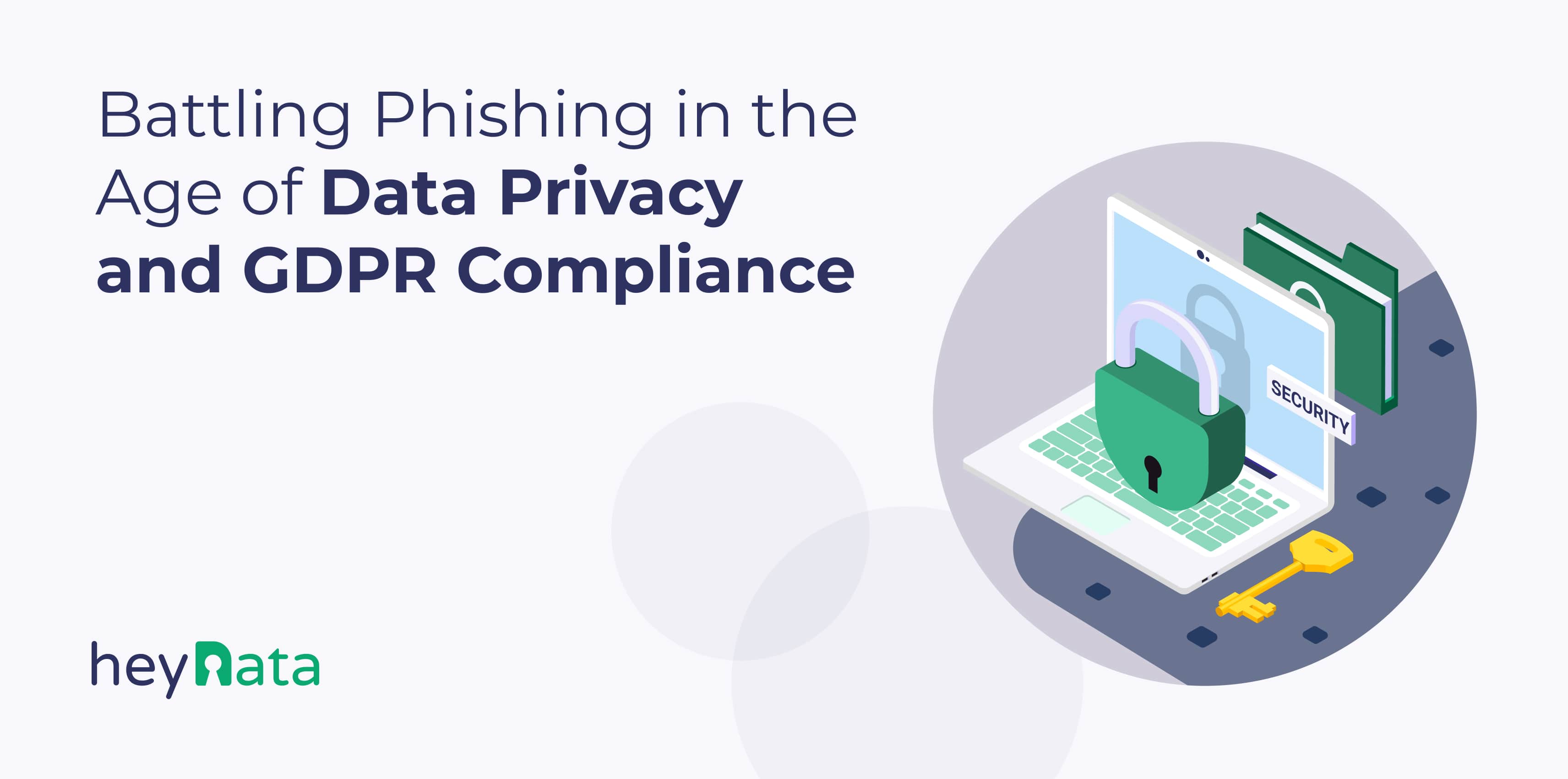
Battling Phishing in the Age of Data Privacy and GDPR Compliance

Dive into the world of email threats and their impact on GDPR. Discover expert strategies to safeguard your organization against phishing and the distinctions between phishing and spam.
Email has become an essential communication mode in our personal and professional lives. However, with the convenience of email comes the ever-looming threats of phishing and spam, which can have severe consequences, particularly for GDPR compliance. In this blog, we will explore the impact of phishing on GDPR, what phishing and spam are, and the measures you can take to protect your organization.
Table of Contents:
What is Phishing and its threat to GDPR Compliance?
Phishing is a form of cyber attack where malicious actors attempt to deceive individuals into revealing sensitive information, such as personal or financial data. Phishers often use deceptive tactics to impersonate trusted entities, tricking people into revealing sensitive information like passwords and financial details by clicking on malicious links or downloading harmful attachments. The consequences of successful phishing attacks can be devastating, including identity theft, financial losses, and data breaches. In 2023, 33 million data records are expected to be compromised due to phishing attacks.
The use of AI in phishing attacks is a growing concern, as it not only assists attackers in creating convincing phishing messages but also enables them to evade detection by security systems. With AI algorithms, cybercriminals can carefully analyze and replicate legitimate communication patterns, making it increasingly challenging for traditional security measures to identify malicious content. OpenAI tools such as ChatGPT has gained popularity among cybercriminals as it enables them to target unsuspecting individuals and create both false information and deceptive content.
Related Topic: The legal status of ChatGPT
This ongoing battle between attackers and defenders underscores the pressing demand for creative and adaptable cybersecurity solutions. Here are some key characteristics of phishing attacks:
| Deceptive Impersonation | Phishing emails are crafted to appear as if they come from legitimate and trustworthy sources, often using official logos, email addresses, and language. |
| Social Engineering | Phishing relies on psychological manipulation to trick recipients into taking actions like clicking on malicious links, downloading attachments, or sharing confidential information. |
| Types of Phishing | There are various forms of phishing, including deceptive phishing, spear phishing (targeting specific individuals or organizations), and whaling (targeting high-profile individuals within an organization). |
| Potential Damage | Falling for a phishing attack can lead to identity theft, financial loss, or the compromise of sensitive data. |
Phishing attacks pose a direct threat to GDPR compliance due to their potential to compromise sensitive personal data. These attacks impact GDPR in various ways, including:
Data Breaches
Phishing emails often aim to trick individuals into revealing personal information or login credentials. When successful, these attacks can lead to data breaches, which must be reported under GDPR. Failure to report a violation promptly can result in severe penalties.
Unauthorized Data Processing
Phishing attacks can lead to unauthorized access to personal data, violating GDPR's principles of lawful data processing and the requirement to protect data against unauthorized access.
Consent Manipulation
Some phishing attempts use deceptive tactics to manipulate individuals into consenting for data processing. This fraudulent consent does not meet GDPR's requirement for explicit, informed, and freely given consent.
Security Measures
GDPR mandates robust data security measures. A successful phishing attack can undermine these safeguards, making an organization non-compliant with GDPR's security requirements.
How AI Enables Sophisticated Phishing Attacks
The use of AI in phishing attacks is a growing concern, as it not only assists attackers in creating convincing phishing messages but also enables them to evade detection by security systems. With AI algorithms, cybercriminals can carefully analyze and replicate legitimate communication patterns, making it increasingly challenging for traditional security measures to identify malicious content. This ongoing battle between attackers and defenders underscores the pressing demand for creative and adaptable cybersecurity solutions.
Mitigating the Risks of Phishing for GDPR Compliance
Maintaining GDPR compliance and safeguarding personal data from the pervasive threat of phishing is paramount for organizations. Here are key measures to consider for mitigating the risks of phishing and upholding GDPR compliance:
| Employee Training | Educate employees about the risks of phishing and train them to recognize and report suspicious emails. Well-informed employees are the first line of defense against phishing attacks. |
| Email Filtering and Authentication | Implement advanced email filtering solutions to identify and block phishing emails. Additionally, use email authentication protocols like DMARC to prevent email spoofing. |
| Multi-Factor Authentication (MFA) | Require MFA for access to sensitive systems and data. Even if phishing attempts compromise login credentials, MFA can provide an extra layer of security. |
| Data Encryption | Encrypt sensitive personal data to protect it in case of a breach. GDPR does not mandate encryption, but it is an effective security measure. |
| Incident Response Plan | Develop a robust incident response plan that includes clear procedures for handling data breaches, as GDPR requires. This plan should outline how to report breaches and notify affected individuals promptly. |
| Regular Auditing and Assessment | Conduct regular audits of security measures to ensure they align with GDPR requirements. Continuously assess and improve security protocols. |
How to Differentiate Between Phishing and Spam
| Commercial Messages | Spam emails are usually focused on promoting products or services, often from unknown or dubious sources. |
| Email Overload | Spam email can quickly clog up your inbox and slow down email servers, making it a nuisance for both individuals and businesses. |
| Less Malicious | While spam can be annoying and sometimes contain malware or links to harmful websites, its primary goal is commercial, not to steal personal information. |
Identifying whether you've received a phishing or spam email can be challenging, as both types may end up in your inbox. The key difference between phishing and spam emails lies in their intent and content. Phishing emails usually aim to deceive and steal sensitive information, often using formal language and urgency, while spam emails are primarily focused on commercial promotion and tend to come from random or unfamiliar sources without the same level of urgency. It's important to be vigilant and cautious when dealing with both types of emails to protect your personal information and computer security.
| Phishing Emails | These emails often include links to malicious websites, use more formal language, may create a sense of urgency, and may spoof sender addresses to look legitimate. |
| Spam Emails | Spam is typically more casual, may contain promotional content, often has random or unfamiliar sender addresses, and lacks the urgency associated with phishing. |
Conclusion
While phishing and spam are email-based threats, they have different objectives and characteristics. By understanding these differences and adopting good data security practices, you can better protect your business from falling victim to these cyber threats.
Alternatively, an External Data Protection Officer serves as an excellent solution for businesses facing challenges such as limited cyber security knowledge, resources, or financial constraints. These dedicated data protection professionals bring the necessary expertise to help businesses prevent cyberattacks proactively, establish resilient security measures, and remain ahead of potential threats.
Don't miss out on the latest insights and stay ahead on all things compliance! Subscribe to our email newsletter to get more data protection updates and the latest blogs delivered right to your inbox.


